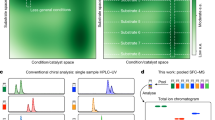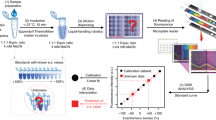Abstract
A simple three-component chiral derivatization protocol for determining the enantiopurity of chiral primary amines by 1H NMR spectroscopic analysis is described here. The method involves condensation of the amines with 2-formylphenylboronic acid and enantiopure 1,1′-bi-2-naphthol. This approach affords a mixture of diastereoisomeric iminoboronate esters whose ratio can be determined by the integration of well-resolved diastereotopic resonances in their 1H NMR spectra, thus enabling the enantiopurity of the parent amine to be determined easily. The protocol, as described, takes less than 90 min to complete.
This is a preview of subscription content, access via your institution
Access options
Subscribe to this journal
Receive 12 print issues and online access
$259.00 per year
only $21.58 per issue
Buy this article
- Purchase on Springer Link
- Instant access to full article PDF
Prices may be subject to local taxes which are calculated during checkout




Similar content being viewed by others
References
Koutsaplis, M. et al. A new diastereoselective aza–allyl conjugate addition–Michael addition–ring closure reaction sequence and its application in the construction of six contiguous stereogenic centres. Chem. Commun. 3580–3582 (2007).
Bull, S.D. et al. Enantiodiscrimination of racemic electrophiles by diketopiperazine enolates: asymmetric synthesis of methyl 2-amino-3-aryl-butanoates and 3-methyl-aspartates. Tetrahedron 62, 7911–7925 (2006).
Kitamura, M., Shirakawa, S. & Maruoka, K. Powerful chiral phase-transfer catalysts for the asymmetric synthesis of alpha-alkyl- and alpha,alpha-dialkyl-alpha-amino acids. Angew. Chem. Int. Ed. 44, 1549–1551 (2005).
Wang, C.-J., Sun, X. & Zhang, X. Enantioselective hydrogenation of allylphthalimides: an efficient method for the synthesis of beta-methyl chiral amines. Angew. Chem. Int. Ed. 44, 4933–4935 (2005).
Sugiura, M., Hirano, K. & Kobayashi, S. alpha-Aminoallylation of aldehydes with ammonia: stereoselective synthesis of homoallylic primary amines. J. Am. Chem. Soc. 126, 7182–7183 (2004).
Bull, S.D. et al. 2-Halo-diketopiperazines as chiral glycine cation equivalents. Tetrahedron Asymmetry 15, 3989–4001 (2004).
Kadyrov, R. & Riermeier, T.H. Highly enantioselective hydrogen-transfer reductive amination: catalytic asymmetric synthesis of primary amines. Angew. Chem. Int. Ed. 42, 5472–5474 (2003).
Bull, S.D. et al. Asymmetric synthesis of β-pyridyl-β-amino-acid derivatives. J. Chem. Soc. Perkin Trans. I 34, 1858–1868 (2002).
Mellin-Morlière, C., Aitken, D.J., Bull, S.D., Davies, S.G. & Husson, H-P. A practical asymmetric synthesis of homochiral α-arylglycines. Tetrahedron Asymmetry 12, 149–155 (2001).
Bull, S.D., Davies, S.G. & O'Shea, M.D. Stereoselective conjugate addition of organocuprates to a dehydroalanine-derived diketopiperazine. J. Chem. Soc. Perkin Trans. I 3657–3658 (1998).
Rodríguez-Escrich, S., Popa, D., Jimeno, C., Vidal-Ferran, A. & Pericàs, M.A. (S)-2-[(R)-fluoro(phenyl)methyl]oxirane: a general reagent for determining the ee of alpha-chiral amines. Org. Lett. 7, 3829–3832 (2005).
Chin, J., Kim, D.C., Kim, H.-J., Panosyan, F.B. & Kim, K.M. Chiral shift reagent for amino acids based on resonance-assisted hydrogen bonding. Org. Lett. 6, 2591–2593 (2004).
López, B., Quiñoá, E. & Riguera, R. Complexation with barium(II) allows the inference of the absolute configuration of primary amines by NMR. J. Am. Chem. Soc. 121, 9724–9725 (1999).
Manuel Seco, J., Quiñoá, E. & Riguera, R. Boc-phenylglycine: the reagent of choice for the assignment of the absolute configuration of α-chiral primary amines by 1H NMR spectroscopy. J. Org. Chem. 64, 4669–4675 (1999).
Chinchilla, R., Falvello, L.R. & Nájera, C. Determination of the absolute configuration of amines and α-amino acids by 1H NMR of (R)-O-aryllactic acid amides. J. Org. Chem. 61, 7285–7290 (1996).
Hoye, T.R. & Renner, M.K. Applications of MTPA (Mosher) amides of secondary amines: assignment of absolute configuration in chiral cyclic amines. J. Org. Chem. 61, 8489–8495 (1996).
Kolodiazhnyi, O.I., Demchuk, O.M. & Gerschkovich, A.A. Application of the dimenthyl chlorophosphite for the chiral analysis of amines, amino acids and peptides. Tetrahedron Asymmetry 10, 1729–1732 (1999).
Hulst, R., Zijlstra, R.W.J., de Vries, N.K. & Feringa, B.L. (S)-2H-2-oxo-5,5-dimethyl-4(R)-phenyl-1,3,2-dioxaphosphorinane, a new reagent for the enantiomeric excess determination of unprotected amino acids using 31P NMR. Tetrahedron Asymmetry 5, 1701–1710 (1994).
Sullivan, G.R., Dale, J.A. & Mosher, H.S. Correlation of configuration and fluorine-19 chemical shifts of alpha-methoxy-alpha-trifluoromethylphenyl acetate derivatives. J. Org. Chem. 38, 2143–2147 (1973).
Trost, B.M., Bunt, R.C. & Pulley, S.R. On the use of o-methylmandelic acid for the establishment of absolute configuration of alpha-chiral primary amines. J. Org. Chem. 59, 4202–4205 (1994).
Seco, J.M., Quiñoá, E. & Riguera, R. The assignment of absolute configuration by NMR. Chem. Rev. 104, 17–118 (2004).
Svatoš, A., Valterová, I., Saman, D. & Vrkoc, J. Direct esterification of 2-methoxy-2-phenyl-3,3,3-trifluoropropionic acid: a reinvestigation. Collect. Czech. Chem. Commun. 55, 485–490 (1990).
Hietaniemi, L., Pohjala, E., Malkonen, P. & Riekkola, M.L. Assay of enantiomeric purities of beta-blockers-complications in the Mosher method. Finn. Chem. Lett. 16, 67–73 (1989).
Pérez-Fuertes, Y. et al. Simple protocol for NMR analysis of the enantiomeric purity of primary amines. Org. Lett. 8, 609–612 (2006).
Kelly, A.M., Pérez-Fuertes, Y., Arimori, S., Bull, S.D. & James, T.D. Simple protocol for NMR analysis of the enantiomeric purity of diols. Org. Lett. 8, 1971–1974 (2006).
Axe, P. et al. Enantiopure pseudo-C3-symmetric titanium alkoxide with propeller-like chirality. Org. Lett. 9, 223–226 (2007).
Taylor, P.J.M. & Bull, S.D. An improved synthesis of deuterated Schöllkopf's bis-lactim ether and its use for the asymmetric synthesis of (R)-[α-2H]-phenylalanine methyl esters. Tetrahedron Asymmetry 17, 1170–1178 (2006).
James, T.D. Saccharide-selective boronic acid based photoinduced electron transfer (PET) fluorescent sensors. Top. Curr. Chem. 277, 107–152 (2007).
James, T.D. & Shinkai, S. Artificial receptors as chemosensors for carbohydrates. Top. Curr. Chem. 218, 159–200 (2002).
Allenmark, S.G. Chromatographic Enantioseparation: Methods and Applications. Ellis Horwood, Chichester, UK, (1988).
Weix, D.J., Dreher, S.D. & Katz, T.J. HELOL phosphite: a helically grooved sensor of remote chirality. J. Am. Chem. Soc. 122, 10027–10032 (2000).
Acknowledgements
We wish to thank the University of Bath, the EPSRC, the Leverhulme Trust and the Royal Society for financial support.
Author information
Authors and Affiliations
Corresponding authors
Rights and permissions
About this article
Cite this article
Pérez-Fuertes, Y., Kelly, A., Fossey, J. et al. Simple protocols for NMR analysis of the enantiomeric purity of chiral primary amines. Nat Protoc 3, 210–214 (2008). https://doi.org/10.1038/nprot.2007.524
Published:
Issue Date:
DOI: https://doi.org/10.1038/nprot.2007.524
This article is cited by
Comments
By submitting a comment you agree to abide by our Terms and Community Guidelines. If you find something abusive or that does not comply with our terms or guidelines please flag it as inappropriate.



